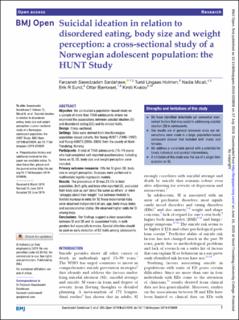Suicidal ideation in relation to disordered eating, body size and weight perception: a cross-sectional study of a Norwegian adolescent population: the HUNT study
S Sardahaee, Farzaneh; Holmen, Turid Lingaas; Micali, Nadia; Sund, Erik; Bjerkeset, Ottar; Kvaløy, Kirsti
Peer reviewed, Journal article
Published version
Permanent lenke
https://hdl.handle.net/11250/2659011Utgivelsesdato
2019Metadata
Vis full innførselSamlinger
Originalversjon
Sardahaee, F. S., Holmen, T. L., Micali, N., Sund, E. R., Bjerkeset, O. & Kvaløy, K. (2019). Suicidal ideation in relation to disordered eating, body size and weight perception: a cross-sectional study of a Norwegian adolescent population: the HUNT study. BMJ Open, 9(7): e029809. doi: 10.1136/bmjopen-2019-029809Sammendrag
Objective We conducted a population-based study on a sample of more than 7000 adolescents where we examined the associations between suicidal ideation (SI) and disordered eating (DE) and its related traits.
Design Cross-sectional.
Settings Data were derived from two Norwegian population-based cohorts, the Young-HUNT1 (1995–1997) and Young-HUNT3 (2006–2008) from the county of Nord-Trøndelag, Norway.
Participants A total of 7268 adolescents (15–19 years) who had completed self-reported questionnaires including items on SI, DE, body size and weight perception were included.
Primary outcome measures ORs for SI given DE, body size or weight perception. Analyses were performed in multivariate logistic regression models.
Results The prevalence of SI was 23.1% in total population. Both girls and boys who reported DE, evaluated their body size as not ‘about the same as others’ or were ‘unhappy about their weight’ had between twofold to fivefold increase in odds for SI; these incremental risks were observed independent of sex, age, body mass index and socioeconomic status. We observed higher odds for SI among boys.
Conclusions Our findings suggest a clear association between SI and DE and its associated traits, in both genders but especially in males. Special attention should be paid on early detection of DE traits among adolescents.

